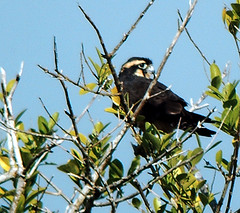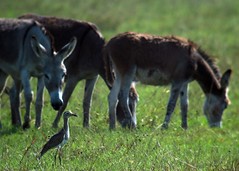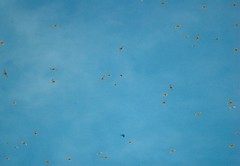Wow! Veracruz was amazing.
Our lab (Ben, Blake and myself + Holly Vuong from the Morin lab in our department) presented our research down at the North American Ornithologists’ Conference, in Veracruz, Mexico last week. It was no accident that the organizers scheduled the conference during the peak of Broad-winged Hawk migration, and although we never witnessed the 500,000-bird days-of-lore, we did have a spectacular 190,000+ raptor day last Thursday that rocked our socks. Veracruz not only provides world renowned hawkwatching, but also some fantastic birding in all sorts of habitats from lowland marshes to cloud forest. We spent several days prior to the conference taking in the local sights such as Las Barrancas grasslands where we saw Aplomado Falcon

and Double-striped Thick-knee

to name my favorites.
We visited the hawkwatch at Cardel once a day for the first few days in hopes of a good flight, but were only treated with teaser kettles (or vortexes, if you’re in Mexico) in the distance although we did manage a really cool kettle of over 60 Anhingas on one of the slow days.
On Thursday though we witnessed what everyone talks about when referring to migration in Veracruz: HUGE kettles of hawks, mostly Broad-winged and some Turkey Vultures, but with a smattering of Swainson’s hawks and the occasional Gray Hawk, Short-tailed Hawk, Mississippi or Swallow-tailed Kite.

There were also two Common Black Hawks riding the thermals between the hawkwatch and the mountains providing great views to all on the rooftop. The sheer magnificence of the kettles forming and swirling up into the atmosphere, where the birds then peel off into a ribbon (or river!) of raptors that extends over the hawkwatch and as far beyond as the eye can see, is almost impossible to describe in words. It begins with just a slight shimmering on the horizon, over the mountains. Like the air is speckled with tinsel. These birds, broad-winged hawks, are then joined by darker objects more discernable through binoculars as Turkey Vultures. As the swarm of birds gains altitude in the thermal, more birds join from below, and the column grows into a swirling writhing vortex. At some high altitude the effect of the thermal dissipates, and birds orient themselves in the desired direction and begin to peel off in a glide. From the hawkwatch we watched several ‘streams’ originating from several different thermal columns, all streaking past our post and behind us into the southern horizon. Each time one thermal seemed to become exhausted, another would start up and the process would repeat itself.
Prior to this visit I had heard folks talking about the hawkwatch. Mostly it was, “yeah, there are a lot of birds, but they’re counting on a rooftop in the middle of the city…not necessarily the scenic view I’d want at a hawkwatchâ€. Now after experiencing it, I can officially put down my foot and say that while it’s no Raccoon Ridge, it’s still definitely a great place to watch raptor migration. Take in this image for a moment: I’m on the rooftop of the highest building in the city, looking out on a forest green range of mountains to the north, and beyond the limits of the city to either side are vast grasslands and agricultural fields, while the ocean is visible in the distant east. Kiskadees, Tropical Kingbirds, Yellow-winged Tanager, Great-tailed Grackles and Melodius Blackbirds chatter below in the trees. My right hand is resting on my scope while I scan the horizon for new forming kettles. My left hand is wrapped around an ice cold Negra Modelo that I just purchased from the hawkwatch concession. Oh, a kettle of 20,000 birds just popped up in the distance….hawk watching doesn’t get much better than this. 🙂
For more information on the River of Raptors hawkwatch, click here for the Pronatura Veracruz website
One response to “Back from Mexico”
Wow, David.
I’m jealous. The highlight of my season was a couple of Peregrines dive-bombing off the Tappan Zee.
Love the shot of the fork-tailed flycatcher up on Flickr.